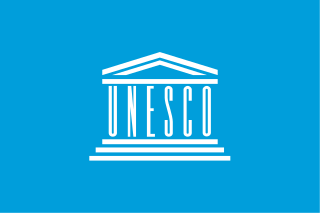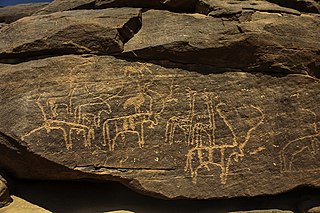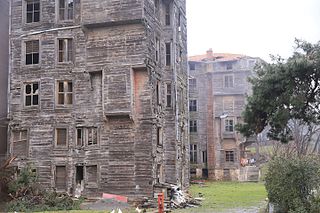
A World Heritage Site is a landmark or area with legal protection by an international convention administered by the UNESCO. World Heritage Sites are designated by UNESCO for having cultural, historical, scientific or other forms of significance. The sites are judged to contain "cultural and natural heritage around the world considered to be of outstanding value to humanity".
World Monuments Fund (WMF) is a private, international, non-profit organization dedicated to the preservation of historic architecture and cultural heritage sites around the world through fieldwork, advocacy, grantmaking, education, and training.

El Mirador is a large pre-Columbian Middle and Late Preclassic Maya settlement, located in the north of the modern department of El Petén, Guatemala. It is part of the Mirador-Calakmul Karst Basin of northern Guatemala.

Ciudad Perdida is the archaeological site of an ancient city in the Sierra Nevada de Santa Marta of Colombia, within the jurisdiction of the municipality of Santa Marta. This city is believed to have been founded about 800 AD. If so, Ciudad Perdida predates Machu Picchu by about 650 years.

Chavín de Huántar is an archaeological site in Peru, containing ruins and artifacts constructed as early as 1200 BC, and occupied until around 400–500 BC by the Chavín, a major pre-Inca culture. The site is located in the Ancash Region, 434 kilometers (270 mi) north of Lima, at an elevation of 3,180 meters (10,430 ft), east of the Cordillera Blanca at the start of the Conchucos Valley.
J. Jeffrey Morgan is an American conservationist and former technology executive. He is best known for founding Global Heritage Fund (GHF), a non-profit organization that works internationally to preserve cultural heritage sites in the developing world. From 2002 to 2012, Morgan served as GHF's Executive Director.

The Rice Terraces of the Philippine Cordilleras are a World Heritage Site consisting of a complex of rice terraces on the island of Luzon in the Philippines. They were inscribed on the UNESCO World Heritage List in 1995, the first-ever property to be included in the cultural landscape category of the World Heritage List. This inscription has five sites: the Batad Rice Terraces and Bangaan Rice Terraces, Mayoyao Rice Terraces, Hungduan Rice Terraces and Nagacadan Rice Terraces, all in Ifugao Province. The Ifugao Rice Terraces reach a higher altitude and were built on steeper slopes than many other terraces. The Ifugao complex of stone or mud walls and the careful carving of the natural contours of hills and mountains combine to make terraced pond fields, coupled with the development of intricate irrigation systems, harvesting water from the forests of the mountain tops, and an elaborate farming system.

Europa Nostra is a pan-European Federation for Cultural Heritage, representing citizens' organisations that work on safeguarding Europe's cultural and natural heritage. It is the voice of this movement to relevant international bodies, in particular the European Union, the Council of Europe and UNESCO. It has consultative status with UNESCO and is recognised as an NGO partner.

Ani is a ruined medieval Armenian city now situated in Turkey's province of Kars, next to the closed border with Armenia.

The United Nations Educational, Scientific and Cultural Organization (UNESCO) is a specialized agency of the United Nations (UN) with the aim of promoting world peace and security through international cooperation in education, arts, sciences and culture. It has 194 member states and 12 associate members, as well as partners in the non-governmental, intergovernmental and private sector. Headquartered in Paris, France, UNESCO has 53 regional field offices and 199 national commissions.
The World Monuments Watch is a flagship advocacy program of the New York-based private non-profit organization World Monuments Fund (WMF) that calls international attention to cultural heritage around the world that is threatened by neglect, vandalism, conflict, or disaster.
Saving Our Vanishing Heritage: Safeguarding Endangered Cultural Heritage Sites in the Developing World was a report released by Global Heritage Fund on October 17, 2010. It illuminated five accelerating man-made threats facing global heritage sites in developing countries: development pressures, unsustainable tourism, insufficient management, looting, and war and conflict.

Marcahuamachuco is an archeological site of Pre-Incan ruins in the La Libertad Region of Peru. Although less well-known than other sites, it is considered significant and has been referred to by archaeologists as "Machu Picchu of the North" and "The Jewel of La Libertad."

Sabu is a village located in the Nile Valley of northern Sudan approximately 600 kilometres northwest of Khartoum. It is best known for the nearby Sabu-Jaddi site containing hundreds of Neolithic-era rock-art panels depicting giraffes, New Kingdom ships, and Christian churches. The site has yet to be systematically studied by archaeologists and is currently threatened by the $705 million Kajbar Dam project, which scientists say will flood the site within six years.
Saint Hilarion Monastery, at the archaeological site of Tell Umm el-'Amr, is an ancient Christian monastery close to Deir al-Balah in the Gaza Strip, Palestine.
Way On Cemetery is a burial place in Panama City for the country's Chinese community, many of whose ancestors immigrated during the construction of the Panama Railroad in the mid-nineteenth century. The plot was purchased in 1882 by the Sociedad Way On and designed in accordance with feng shui and numerology traditions. Construction began the next year, and the first interment was in 1911. In 1942, due to a shortage of burial places in the city, half of the property was forcibly leased by the government, but it was returned to the Chinese community in 2002. Today, traditional Tomb Sweeping ceremonies are held annually and funeral ceremonies are performed regularly.

The Prinkipo Greek Orphanage is a historic 20,000-square-meter wooden building on Büyükada, one of the nine Princes' Islands off the coast of Istanbul, Turkey, in the Sea of Marmara. It is considered the largest wooden building in Europe and second largest in the world. It served as an orphanage from 1903 to 1964.

Maluti temples are a group of 72 extant terracotta temples, located in the Maluti village near Shikaripara in Dumka district on the eastern part of the Chota Nagpur Plateau, Indian state of Jharkhand. These temples, according to the Indian Trust for Rural Heritage and Development (ITRHD), were built between the 17th and 19th centuries. The kings of Baj Basanta dynasty built these temples in Maluti, their capital, inspired by goddess Mowlakshi, their family deity. Many of the temples are deified with different denominations of gods and goddesses, apart from the tutelary deity Mowlakshi, and others such as Shiva, Durga, Kali and Vishnu. The Global Heritage Fund (GHF) has proposed a conservation effort, which would increase tourism to the Maluti village. GHF has declared this site as one of the world's 12 most endangered cultural heritage sites.
Biosphere reserves are areas comprising terrestrial, marine and coastal ecosystems. The biosphere reserve title is handed over by UNESCO. Each reserve promotes solutions reconciling the conservation of biodiversity with its sustainable use. Biosphere reserves are 'Science for Sustainability support sites' – special places for testing interdisciplinary approaches to understanding and managing changes and interactions between social and ecological systems, including conflict prevention and management of biodiversity. Biosphere reserves are nominated by national governments and remain under the sovereign jurisdiction of the states where they are located. Their status is internationally recognized.












